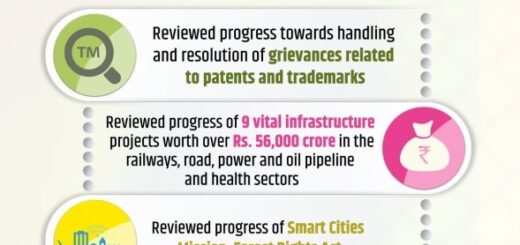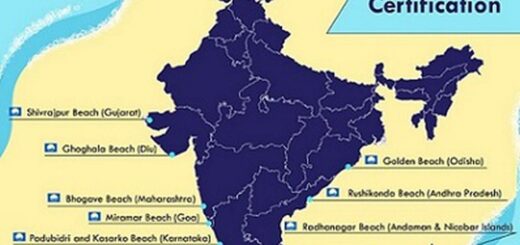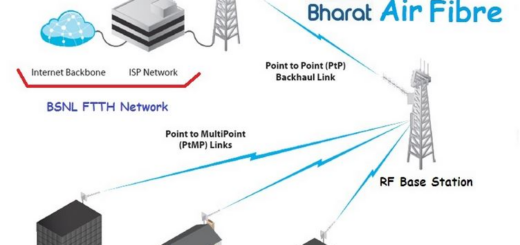National Current Affairs – UPSC/IAS Exams – 29th July 2019
BRICS
 Topic: International Groupings
Topic: International Groupings
In News: Terrorism and Venezuelan crisis were discussed at the recent BRICS ministerial meeting.
More on the Topic:
- At the meeting, the five foreign ministers all agreed to safeguard the purposes and principles of the UN Charter, defend multilateralism and free trade, oppose unilateralism and protectionism, strengthen global governance, and build a community with a shared future for humankind.
- They agreed that regional hotspot issues should be resolved through dialogue and consultation and that BRICS cooperation should work to benefit the peoples of the five countries.
- The foreign ministers also agreed to maintain vigilance on cybersecurity issues and expressed opposition to the use of cybersecurity to suppress the development of science and technology in other countries.
- They agreed to strive toward an open and non-discriminatory environment for the application of information technology.
- The foreign ministers were tasked with preparing for the BRICS summit to be held in Brasilia in November.
About BRICS:
- BRICS is an acronym for the grouping of the world’s leading emerging economies, namely Brazil, Russia, India, China and South Africa.
- Together, BRICS accounts for about 40% of the world’s population and about 30% of the GDP (Gross Domestic Product), making it a critical economic engine.
- It’s an emerging investment market and global power bloc.
- The first BRIC Summit took place in 2009 in the Russian Federation and focused on issues such as reform of the global financial architecture.
- South Africa was invited to join BRIC in December 2010, after which the group adopted the acronym BRICS.
- BRICS is emerging as a new and promising political-diplomatic entity with diverse objectives, far beyond the original objective of reforming global financial institutions.
New Development Bank:
- During the Sixth BRICS Summit in Fortaleza (2014) the leaders signed the Agreement establishing the New Development Bank (NDB).
- NDB’s key areas of operation are clean energy, transport infrastructure, irrigation, sustainable urban development and economic cooperation among the member countries. NDB is headquartered in Shanghai.
Source: Hindu and Wikipedia
Topic: Governance/ Social Justice
In News: Former chief justice of Delhi High Court, Justice A.P. Shah, said there is a need to engage in how the Vishaka guidelines, which deal with sexual harassment in the workplace, should be made applicable to the judiciary.
More on the Topic:
- In 1997, India’s women celebrated a landmark moment when the Supreme Court formulated the Vishaka guidelines that made it mandatory for institutions across the country to put in place measures to prevent and redress sexual harassment in the workplace.
- The Vishakha guidelines laid the foundation for the Sexual Harassment of Women at Workplace (Prevention, Prohibition and Redressal) Act, 2013.
The Guidelines issued by the court said that:
- It shall be the duty of the employer or other responsible persons in workplace or other institutions to prevent or deter the acts of sexual harassment and to provide the procedures for the resolution, settlement or prosecution of acts of sexual harassment by taking all steps required.
- The rules/regulations of the government and the public sector bodies relating to conduct and discipline should include rules/regulation Prohibiting sexual harassment and provide for appropriate penalties in such rules against the offender.
- As regards private employers, steps should be taken to include the aforesaid prohibitions in the standing orders under the Industrial employment (Standing Orders)Act, 1946.”
The Sexual Harassment of Women at Workplace (Prevention, Prohibition and Redressal) Act, 2013:
- This act was enacted in April 2013 as India’s first law dealing with the protection of women against sexual harassment at workplace. Some important feature of this act are as follows:
- This Act aimed to provide every woman, irrespective of her age or employment status, a safe and secure working environment free from all forms of harassment.
- This Act covered both the organized and unorganized sectors in India. The statute applied to all government bodies, private and public sector organizations, non-governmental organizations, organizations carrying out commercial, vocational, educational, entertainment, industrial, financial activities, hospitals etc.
- This Act defined ‘sexual harassment’ in line with the Supreme Court’s definition in the Vishaka Judgment.
- The Act extended the meaning of the word sexual harassment to include “presence or occurrence of circumstances of implied or explicit promise of preferential treatment in employment, threat of detrimental treatment in employment, threat about present or future employment, interference with work or creating an intimidating or offensive or hostile work environment, or humiliating treatment likely to affect the lady employee’s health or safety could also amount to sexual harassment”.
- The Act also introduced the concept of ‘extended workplace’ since sexual harassment is not always confined to the primary place of employment. Therefore, the Act defined ‘workplace’ to include any place visited by the employee arising out of or during the course of employment, including transportation provided by the employer for the purpose of commuting to and from the place of employment.
- The Act provided for the establishment of Internal Complaints Committee (ICC) at each and every office or branches of the organization employing 10 or more employees, in order to provide a forum for filing complaints to facilitate fast redressal of the grievances pertaining to sexual harassment.
- It also provided for the establishment of local complaints committee (LCC) at the district level by the Government to investigate and redress complaints of sexual harassment of the unorganized sector or from those establishments where the ICC has not been constituted for the reason being, it having less than 10 employees.
Challenges:
- Lack of initiative on the part of government authorities to monitor the implementation and enforce the law.
- The government at the State level has not even bothered to appoint district officers or local committees under the 2013 Act.
- There are no appointments of nodal officers or internal complaints committees in certain offices.
- There has been no move to ensure the reporting and collection of annual compliance reports from workplaces. Hence, the law meant to protect working women has hit a roadblock.
Model Mains Question: Analyse the importance of Vishaka guide lines in ensuring safety for women at workplaces.
Source: Hindu, The Statesman
Topic: Security
In News: The new concept of Integrated Battle Groups (IBGs) which the Army plans to create as part of overall force transformation will be implemented soon.
More on the Topic:
- IBGs are brigade-sized, agile, self-sufficient combat formations, which can swiftly launch strikes against adversary in case of hostilities.
- Each IBG would be tailor-made based on Threat, Terrain and Task and resources will be allotted based on the three Ts. They need to be light so they will be low on logistics.
- They will be able to mobilise within 12-48 hrs based on the location.
- While a command is the largest static formation of the Army spread across a defined geography, a corps is the largest mobile formation. Typically each corps has about three brigades.
- The idea is to re-organise them into IBGs which are brigade-sized units but have all the essential elements like infantry, armoured, artillery and air defence embedded together based on the three Ts. An IBG operating in a desert needs to be constituted differently from an IBG operating in the mountains.
- The IBGs will also be defensive and offensive. While the offensive IBGs would quickly mobilise and make thrust into enemy territory for strikes, defensive IBGs would hold ground at vulnerable points or where enemy action is expected. The composition of the IBGs would also depend on this.
Source: The Hindu
Topic: Governance
In News: Himalayan States came together at a conclave to demand a separate Ministry to deal with problems endemic to them and a green bonus in recognition of their contribution to environment conservation.
More on the Topic:
- Ten out of 11 States took part in the conclave. It is for the first time that the Himalayan States have come on a single platform to take a unanimous stand on the issue of green bonus and demanded a separate Ministry to deal with problems unique to them.
- A green bonus thus was needed to compensate the Himalayan States for their disadvantages.
- The rationale behind the demand was that most of the country’s rivers originate in the Himalayas and therefore, the Himalayan States had to play the most significant role in the Prime Minister’s water conservation initiative.
- It was also necessary because the Himalayan States’ contribution to environmental conservation was the biggest with all their green cover.
- The Himalayan States were also at a disadvantage because large swathes of land fell into eco-sensitive zones where all sorts of development activities could not be carried out.
Source: The Hindu
Topic: Economy
In News: The ‘Deep Ocean Mission (DOM)’ to be led by the Union Earth Sciences Ministry will commence from October 31.
More on the Topic:
- The mission proposes to explore the deep ocean similar to the space exploration started by ISRO about 35 years ago.
- It is a five-year, ₹8,000-crore plan to explore the deepest recesses of the ocean.
- Among the key deliverables are an offshore desalination plant that will work with tidal energy and developing a submersible vehicle that can go to a depth of at least 6,000 metres with three people on board.
- A major thrust of the mission will be looking for metals and minerals.
- India has been allotted a site of 75,000 sq. km. in the Central Indian Ocean Basin (CIOB) by the UN International Sea Bed Authority for exploitation of polymetallic nodules (PMN).
About Polymetallic Nodules:
- These are rocks scattered on the seabed containing iron, manganese, nickel and cobalt.
- Being able to lay hands on even 10% of that reserve can meet the energy requirement for the next 100 years.
- It has been estimated that 380 million metric tonnes of polymetallic nodules are available at the bottom of the seas in the Central Indian Ocean.
- India’s Exclusive Economic Zone spreads over 2.2 million sq. km. and in the deep sea, lies “unexplored and unutilised”.
Source: Hindu, Wikipedia
Why does India say no to Kashmir mediation?
Topic: International Relations
In News: Recently U.S. President Donald Trump claimed that Prime Minister Narendra Modi had sought mediation in Kashmir when they met during the G-20 summit in Osaka. In Parliament, External Affairs Minister S. Jaishankar categorically said that Mr. Modi did not request Mr. Trump to “mediate or arbitrate” on the Kashmir issue. He said India remains committed to discussing all issues with Pakistan bilaterally.
Background:
- In 1993, the new administration of U.S. President Bill Clinton decided to wade into the Kashmir issue, indicating repeatedly that it wished to mediate between India and Pakistan.India issued a strong protest and drawing a red line on the issue of mediation.
- Except Trump No U.S. leader has publicly crossed that line in 25 years. Responding to a swift and angry denial from the Ministry of External Affairs, the U.S. State Department backtracked from the allegation by saying that Kashmir remains a “bilateral issue”, amid the U.S. “stands ready to assist” any India-Pakistan talks.
Why does India refrain from taking help?
- India’s firm position against mediation on Kashmir or any other issue stems from several reasons, most notably a historical suspicion, since the 1950s and 1960s, as mediated talks by the United Nations and World Bank, the United States, the United Kingdom and Russia have been unsuccessful in resolving the issues between India and Pakistan.
- At best, the attempts have worked for diffusing tensions, or calling off hostilities at the Line of Control and the International Border, but not in terms of their rival claims over Jammu and Kashmir.
- Another reason is that India sees itself as a regional leader, and does not require any assistance in sorting out its issues with other regional countries.
- In addition, the widespread belief is that mediation favours the weaker party by levelling the playing field, and with its stronger conventional and non-conventional military prowess, India has seen no significant gain from bringing a third-party into its 70-year-old conflict with Pakistan.
When did the UN try to mediate?
- The early attempts at mediation by the UN were made after India took its complaint against Pakistan’s forced occupation of parts of Kashmir (PoK) to the UN Security Council on January 1, 1948.
- The UN then set up the United Nations Commission for India and Pakistan (UNCIP) which proposed mediating a resolution along a three-point action plan: Pakistani demilitarisation of the Kashmir region, followed by Indian reduction in military presence, and a proposed final resolution by an impartial U.N. administered plebiscite to “determine the wishes of the Kashmiri people”.
- The deal never got off the ground as Pakistan never agreed to demilitarise, and India under Prime Minister Jawaharlal Nehru made it clear that a plebiscite would never be accepted.
- Where the UNCIP was successful was in mediating a ceasefire in 1949, and negotiating the geographical location of the cease-fire line which would be monitored by the United Nations Military Observer Group In India and Pakistan (UNMOGIP).
- Individual U.N. representatives continued to visit both sides from 1949 to 1953 but failed to improve the atmosphere for a resolution, or to convince either side to demilitarise the two sides of the LoC.
- The only exceptions to this dismal record were the 1960 World Bank guaranteed Indus Water Treaty, and a territorial agreement on the Rann of Kutch, mediated successfully by the British government in 1965.
- Soviet Premier Kosygin also moderated between Prime Minister Lal Bahadur Shastri and Pakistani President Ayub Khan to broker the 1965 Tashkent peace agreement, but the treaty has always been marked by suspicion and doubts, tainted by Shastri’s sudden death at Tashkent.
Will India remain opposed to mediation?
- After winning the war with Pakistan that saw the creation of Bangladesh, India, in 1972, negotiated the Simla Agreement, which did away with any idea of future mediation between the two countries. According to the Agreement signed on July 2, 1972 by Indira Gandhi and by then President Bhutto, the two countries “resolved to settle their differences by peaceful means through bilateral negotiations or by any other peaceful means mutually agreed upon between them”.
- In February 1999, the Lahore declaration signed by Nawaz Sharif and Atal Behari Vajpayee also affirmed the bilateral nature of issues and their resolution. Thus, even when Mr. Trump spoke this week, India’s response, in Parliament, was to invoke the Shimla Agreement and the Lahore Declaration saying that they “provide the basis to resolve all issues between India and Pakistan bilaterally”.
- These bilateral efforts are at an end at present, and little has moved since the last negotiations on Kashmir in 2003-2008, when Indian and Pakistani negotiators discussed the four-step formula.
- India has maintained its opposition to third-party mediation, however, and despite offers from several leaders including South African President Nelson Mandela and UN Chief António Guterres.
Source: The Hindu
22 species have gone extinct in India
Topic: Environment and Ecology
In News: According to wildlife survey organisations, Four species of fauna and 18 species of flora have gone extinct in India in the past few centuries.
More on the Topic:
- India is home to 11.5% of all flora in the world. According to the International Union for Conservation Of Nature, a new study has shown that since 1750, more than double the number of plants have disappeared from the wild than birds, mammals and amphibians combined.
- Among mammals, the cheetah (Acionyx jubatus) and the Sumatran rhinoceros (Dicerorhinus sumatrensisi) are considered extinct in India.
- The pink-headed duck (Rhodonessa caryophyllaceai) is feared extinct since 1950 and the Himalayan quail (Ophrysia supercililios) was last reported in 1876.
Causes for Extinction:
- Factors like “competition, predation, natural selection, and human induced factors like hunting, habitat degradation” are some of the important reasons that have led to these extinctions.
Source: The Hindu


















